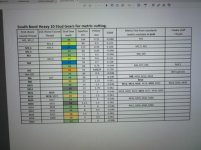SLK001
Stainless
- Joined
- Feb 8, 2015
- Location
- Coral Springs, FL USA
I get that, you'd have to work out the pitch taking into account the 3.5x (or something similary) factor of the carriage feed vs. halfnuts. I did that and found a few extra metric pitches that can be cut, but Peter and Allan's explanation of why one shouldn't makes complete sense to me.
If you can work out a correct pitch using the carriage feed, then go for it. The clutch isn't a "slip clutch" that will slip if it hits something, so if it is tightened properly, it should be just as rigid as your halfnuts. Just remember that once engaged, you don't disengage until the thread is complete.
Either way, threading to a shoulder could be a problem, as once started, you don't disengage the drive for metric (unless you have the elaborate metric thread dial). You'll have to be quick on the cross slide handle to pull the tool out of the cut.


 ) I say.
) I say. 





